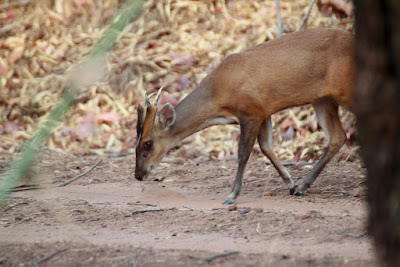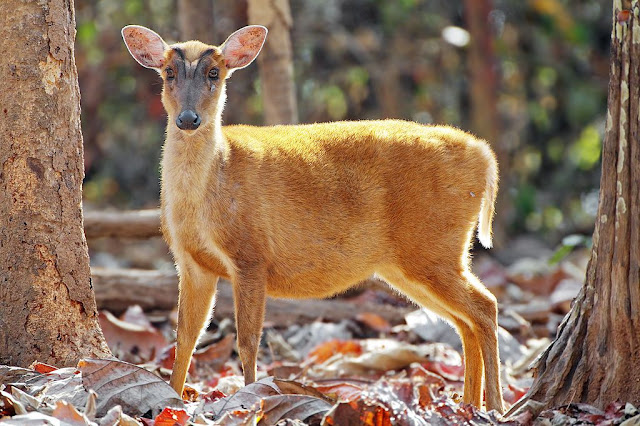Muntjac deer, also called the mastreani deer, is a gathering
of little deer discovered mainly in Southern Asia. The name Muntjac originates
from the Sudanese "mencek", which implies little deer. Muntjac deer
is additionally generally known as the barking deer, due its one of a kind cry
that takes after the bark of a puppy. This gathering of deer consists of 12
known species and a few subspecies, with interesting highlights like little
prongs and canine tusks.
It is quite simple to distinguish between males, females,
adults and youthful ones of the class Muntiacus. Male muntjac deer are bigger
and strong than the female muntjacs. They have little and straight horns that
can grow up to 10 to 15 centimeters in estimate. The muntjac horns re-develop
after they are shed yearly during May and June. The new tusks are become out
totally amongst August and September. Females don't have prongs; instead, they
have a fix of hide on top of the hard handles on their head.
The canines are longer and unmistakably visible in guys,
while, in females, the canines are little and generally secured by their upper
lip. The youthful ones develop rapidly and can achieve the measure of a
grown-up in only multi year, however the grown-ups have more solid and sturdier
bodies.
Like all deer species, muntjacs have eyes set on the sides
of its skull, giving them an extensive variety of vision to spot predators. It
likewise depends on its feeling of smell to spot predators or to find females.
Alongside all the fundamental detects, the deer additionally utilizes an
uncommon intuition, known as the vomeronasal organ. It is situated in the upper
side of the deer's mouth. This organ is utilized to identify synthetic
fragrances left by other creatures. The muntjac particularly utilizes this organ
to find females in oestrus. The muntjac deer buck lifts up its upper lip and
permits air into its mouth, keeping in mind the end goal to detect substance
fragrances left by female muntjacs. A wild muntjac deer is assessed to get by
for up to 10-15 years in its habitat while individuals in captivity have been
recorded to live for up to 20 years.
Muntjacs are small deer, with sizes ranging between 45 to 70
cm among various species. The monster muntjac is the largest all things
considered and a grown-up can weigh up to 60 Kg. Be that as it may, by and
large, a muntjac deer weights anyplace between 10 to 20 kg.
Habitat
Muntjac deer favor calm deciduous timberlands, scrublands
and forests. They jump at the chance to be in a habitat with lavish vegetation
near the ground. These deer are entirely herbivorous and can be seen munching
on delicate leaves, fruits or grass, at whatever point they are dynamic.
They incline toward forests that are near water sources. A
few species of muntjacs are equipped for flourishing even under ominous
conditions, particularly due to their adjustments to deal with or survive their
habitat. They can duplicate whenever of the year and rapidly increase their
numbers. The gathering can unfavorably influence the habitat by overgrazing if
the habitat needs predators of the deer.
With regards to predators, muntjacs are facing a
considerable lot of the toughest predators on the planet. In its range in Asia,
the muntjac habitat consists of top predators like tigers, panthers (snow
panther, blurred panther), wolves, jackals, crocodiles and extensive pythons.
These summit predators have sharp faculties and unmatched
quality, enabling them effectively to chase little deer like the muntjacs. In
any case, the muntjacs' little size causes them to remain covered up in the
low-lying shrubberies to avoid predators.
Reproduction and Lifecycle
The muntjac deer doesn't take after a particular breeding
season. They can breed round the year; females bring forth a single grovel,
once in a while twins. Females achieve sexual maturity sooner than the guys, at
an age of 7 to 9 months, while guys can turn out to be sexually develop between
11 to a year after birth.
Consistently, males scan for females in their territory and
attempt to mate with them. The incubation time frame goes on for up to 230 days
or around 7-8 months. The grovel is little and has visible spots on its jacket.
Females stop lactation, once the stoop is 7 two months old. Grovels have a
decent survival proportion, helping the species to flourish in numbers. Under
great conditions, a muntjac deer can live for up to 15-20 years. The female is
fit for breeding again within a couple of days in the wake of giving birth,
which implies, a doe can bring forth another grovel like clockwork.
Behavior and Communication
Their tendency of interaction with the habitat is yet not
completely understood. Wild muntjacs are spotted dynamic during the day and in
addition during the night. Be that as it may, individuals in captivity tend to
demonstrate a crepuscular conduct. Muntjac deer are solitary slow eaters that
periodically frame little groups of 4-5 individuals. They watch their
territory, in look for nourishment and mates. Females are often observed with a
stoop, and their territory covers with a few other territories of surrounding
guys. Guys are not exceptionally forceful, but rather they get a kick out of
the chance to keep isolate territories. They more often than not tolerate other
muntjacs, yet battles can happen when a female is in question. Male muntjacs
battle with their horns and can make genuine injuries each other. They
additionally make utilization of their long canines, which can tear tissue like
a knife.
The barking sound of a muntjac deer is a caution call to
alarm adjacent muntjacs about a potential risk. The muntjac deer call can be
heard consistently at sunrise and sunset, indicating that it can be a method of
correspondence also. The bark is fundamentally the same as the sound of a
groaning puppy or a fox. Stoops and females screech for their correspondence
with each other. The muntjac is not an exceptionally brilliant animal but
rather, assisted by its faculties and ingrained instincts, it is well fit for
flourishing in its habitat.
Population and Conservation
Muntjac deer are found in Southern Asia and parts of China;
a few species have been introduced in the United Kingdom also. By and large,
the barking deer clan is flourishing due to their quick proliferation rate.
They can replicate whenever of the year and are fit for raising their numbers
rapidly. Be that as it may, when every specie is considered individually, just
a couple are really observed flourishing. Species like the mammoth and dark
muntjac are under danger due to loss of habitat, predation and hunting. Due to
their quick generation rate, they often come in struggle with the neighborhood
populace.
Muntjacs can strike fields and make extreme harm ranchers'
products. Thus, these deer are often gotten with detest at places where human
activity is close-by their habitat. Street movement is additionally one of the
real executioners for muntjacs. With an increasing number of vehicles, numerous
street executes happen when the deer attempts to cross the street looking for
nourishment.
Due to absence of information about their specific habits,
it showed up to a great degree troublesome for specialists to actualize proper
protection measures.
Fun facts
- In spite of the fact that muntjac deer is one of the most established known species of deer, it is likewise one of slightest contemplated species.
- Muntjacs are one of the smallest species of deer on the earth.
- They can reproduce any time of the year.
- Females can mate in a couple of days in the wake of giving birth.
- Muntjacs shed their horns each year.
- Muntjac deer is producing a remarkable cry that takes after the bark of a puppy.
- Its bark is often misunderstood by local people. The groaning sound offers rise to numerous paranormal stories around the locale.
- Despite the fact that herbivorous in nature, their long canine teeth may cause genuine harm if there should arise an occurrence of fighting.
- On average, muntjacs weight just around 10 to 20 kilograms.
- In spite of the fact that they are chased by top predators like tigers, crocs, pythons, panthers and people, muntjacs have made due for more than 25 million years on our planet.




















‘Mastreani’ deer
ReplyDeleteYour website suggests, in common with others, that ‘Mastreani deer’ is an alternative name for the muntjac.
The name has puzzled a great many people, and it turns out that it originated from a mischievous edit on the Wikipedia Muntjac page which has since been corrected. Regrettably, though, such is the popularity of Wikipedia as a source of information that the name managed to spread widely before this happened.
There are more details on page 12 of ‘Digital Deer’, the online version of the Summer 2020 edition of the British Deer Society’s journal Deer if you would like to know more http://www.digitaldeer.co.uk/
It would be greatly appreciated if you might consider removing the reference to ‘Mastreani deer’ from the muntjac information on your website as I am sure that you, like the BDS, would like to help stop the further spread of this inaccurate name.
With many thanks in anticipation
Charles Smith-Jones